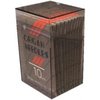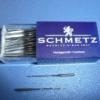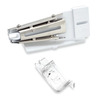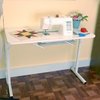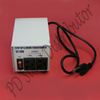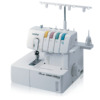
Add up to 6 optional cover stitch guide feet: Hemmer, Bias Tape Holder, Bias Tape Binder, Double Fold Binder, Belt Loop & Top Stitch, or Save on All 6 Combo.
My
- Expand your creativity with Brother's advanced technology. Easy to follow lay-in threading.
- 2 or 3 needle coverstitches, from 3 to 6mm
- Color-coded threading guides.
- Fast and easy looper threading system.
- Dial adjustment for stitch length up to 4mm.
- Stitch length adjustable from 2mm to 4mm.
- Presser foot fabric pressure adjustment.
- Slide lever adjustment for differential feed helps prevent puckering, or can gather light weight fabrics.
- Differential feed for perfect seaming on virtually any fabric type. Eliminates the wavy or stretched appearance of stitched fabrics.
- Snap-on presser foot
* Look at these features: Largest work space on the market (4" x 5.5")
* Presser foot lifter
* Variable stitch length: 2-4mm
* Sews up to 1,000 stitches per minute
* Variable differential feed ratio: 0.7 - 2.0
* Stitch length and differential feed dials located on belt cover for easy handling
The cover stitch is what gives garments their professional looking finish. This stitch called a cover hem was previously available only on the highest-end sergers.
AllBrands is an Authorized Brother Dealer and Service Center for any repairs needed including warranty parts, electrical and labor. We give unlimited technical support by email, fax and phone. We service machines in our stores. Mass merchants do not have tech service or repair departments for your equipment. They are unable to help you directly, only referring any operational, mechanical or electronic questions back to the manufacturer instead of taking care of the problems themselves. Manufacturers and customers should expect that any problems you have will be taken care of by the dealer or merchant who sold you the equipment, not by just referring your questions back to the manufacturer.
The Brother 2340CV is a more economical model, offering a wide 6mm, triple-needle cover stitch and a chain stitch. Because they only do these two types of stitches, they're extremely fast—up to 1,000 stitches per minute—and much easier to set up and use. They look more like regular sewing machines, and offer familiar features that make them easier to use than sergers.
This machine will allow you to hem T-Shirts, attach lace, attach taping and binding, sew decorative stitching, attach elastic, attach lace, do belt loop stitching, circular hemming, attach elastic lace & hem stitching
The cover stitch is especially suited to stretchy fabrics like knits, as well as the popular new blends of traditional woven fabrics with a small percentage of stretch fiber added for extra flexibility. The Cover stitch series machines are ideal for constructing projects from fashion tops to competition ice skating costumes.
The cover stitch is a serger type stitch made without the knives (no fabric is cut), so it can be used not only to finish hems, necklines, collars and cuffs, but also for decorative effects in the middle of the fabric. Cover stitches can be made with two or three needles. For example, a double needle cover stitch will show two lines of straight stitching on the top of the fabric with the two lines joined by a looping stitch on the bottom side. Because both sides of a cover stitch are finished, it looks great with decorative thread.
Chain stitch One-needle, two-thread double chain stitch. For tape binding, joining woven fabrics and decorative effects. Expand your creativity with Brother's advanced technology.
Click HERE for more You Tube Videos on Brother 2340CV Cover Hem Stitch Machine
Click HERE for Online Reviews of Brother 2340CV Cover Hem Stitch Machine
- US Warranty 25 years head, 5 years electronics, 1 years labor
- Non-US Warranty: 30 days parts and labor
Click Here for Brochure on Brother Pacesetter 2340CV Cover Hem Stitch Machine
Click HERE for Instruction Book Operating Manual in English and Spanish for Brother 2340CV Cover Hem Stitch Machine
Click HERE for Parts List Manual for Brother 2340CV Cover Hem Stitch Machine
Click HERE for Service Manual for Brother 2340CV Cover Hem Stitch Machine
- Chain stitch
One-needle, two-thread double chain stitch. For tape binding, joining woven fabrics and decorative effects.
- Decorative stitch
Create special effects by using novelty threads in the lower looper.
- Easy Looper Threading
Fast and easy looper threading system.
- Lay-in threading
Easy to follow lay-in threading and Color-coded threading guide
- Narrow cover stitch (3mm)
Two-needle, three-thread cover stitch. For hemmig on fine fabrics, tape binding and top stitching.
- Tri-cover stitch (6mm)
Three-needle, four-thread cover stitch. For hemmig, decorative effects, elastic and durable seams for sportswear.
- Wide cover stitch (6mm)
Two-needle, three-thread cover stitch. For hemmig, top stitching and decorative effects on T-shirts and knits.
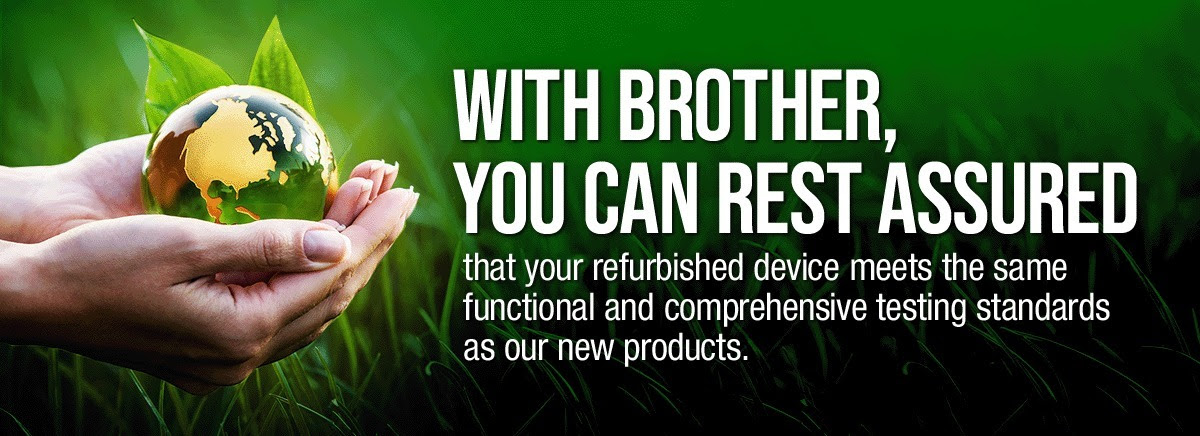
- Soft Dust Cover
- Accessory Bag for tools below
- Tweezers for threading needles and looper
- Thread Net (4)to keep cone threads from "puddling" under spool
- Thread Spool Cap (4)for using cylinder rather than cone theads
- Spool Mat (4)to put under cylinder or cone thread spools
- Cleaning Brush to remove lint
- Hexogonal Wrench
- Needle Set
- Special Presser Foot - The special presser foot is used when an optional attachment is used
- Foot Controller
- Brother 2340CV Instruction Manual in English and Spanish
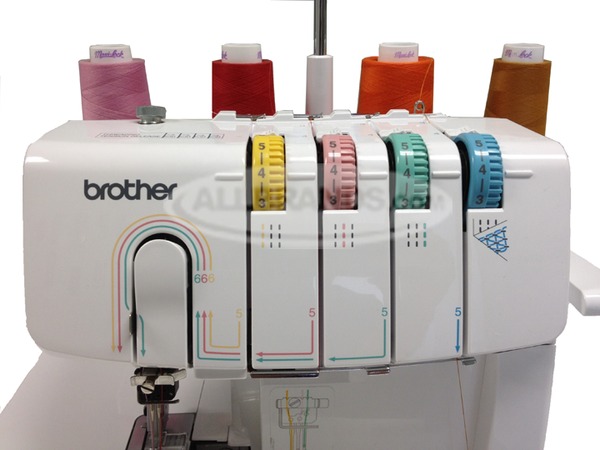 Easy Lay in Threading: Easy to follow lay in threading and color coded threading guide
Easy Lay in Threading: Easy to follow lay in threading and color coded threading guide
 Chain Stitch: One-needle, two-thread double chain stitch. For tape binding, joining woven fabrics and decorative effects.
Chain Stitch: One-needle, two-thread double chain stitch. For tape binding, joining woven fabrics and decorative effects.
 Decorative Stitch: Create special effects by using novelty threads in the lower looper.
Decorative Stitch: Create special effects by using novelty threads in the lower looper.
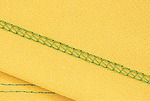 Narrow Cover Stitch (3mm): Two-needle, three-thread cover stitch. For hemming on fine fabrics, tape binding and top stitching.
Narrow Cover Stitch (3mm): Two-needle, three-thread cover stitch. For hemming on fine fabrics, tape binding and top stitching.
 Tri-Cover Stitch (6mm): Three-needle, four-thread cover stitch. For hemming, decorative effects, elastic and durable seams for sportswear.
Tri-Cover Stitch (6mm): Three-needle, four-thread cover stitch. For hemming, decorative effects, elastic and durable seams for sportswear.
 Wide Cover Stitch (6mm): Two-needle, three-thread cover stitch. For hemming, top stitching and decorative effects on T-shirts and knits.
Wide Cover Stitch (6mm): Two-needle, three-thread cover stitch. For hemming, top stitching and decorative effects on T-shirts and knits.
Karen, there are various ways of ending stitches on your Brother 2340CV coverstitch machine. For chaining off you can hold the fabric and coverstitch chain behind the foot with finger pull tension while sewing off, or sew off onto a scrap of fabric/tissue paper.
For tacking at the end of seams, flip the fabric to sew over your previous stitch line, or even turn the hand wheel backwards a few stitches to lock..
If you want to release threads at the end of a seam, you can lift the presser foot up and rock the handwheel back and forth while pulling on all 4 threads, move the looper to the threading position, pull thread slack in front of the two needles, or even turn the tension dials to zero and pull all the threads through at the same time. You should not have to hold each tension dial release button down at the same time. Those buttons where meant to pull thread changes through without any tension, one dial at a time.
I want to get a machine that will allow me serging and/or coverstiching on ANY kind of fabric! I am undecided among three of the machines you sell: the Juki MO735, the Brother 2340CV and 1034. I mainly would like to know what the differences among them are, and if such differences would justify the difference in pricing. It is sometimes hard for me to understand the difference between flatlock and overlock, for example, so not knowing how I could use them in different situations, it doesn't make much sense to get a machine that has them both? So from your expert opinion, which one you would recommend based on what I'm looking for?. Would you recommend that, instead I buy two separate serger and a coverstitch? What would be the main reason for me to buy the MO735 instead of the two others, considering it's more expensive?
The 2-thread stitch is for overcasting a single layer of fabric. It does not have the seam, only the overcast. Of course, you can overcast with the 3 or 4 thread stiches as well. The overlock stitch is a seam with overcast built in. It can be 3, 4 or 5 threads. 3 thread would be for very light weight fabrics, since it's narrower. 3 and 4 thread stitches have stretch, so they are the best stitches for knits, but can also be used on wovens. 4 thread stitch is wider than 3 thread stitch, so it is better for medium weight fabrics. The 5-thread stitch is a straight chain stitch and a 3 thread overlock (separate) and is for heavier fabrics and wovens, since it does not stretch. Flatlock is a variation of the 2-thread or 3 thread overlock stitches. The tension is adjusted so there is no seam, only the overcast. When you sew 2 layers together and pull them flat, the seam allowances are enclosed, so they do not stich out to fold to one side or the other. The fabric is pulled "flat." On one side the stitch looks like a normal overlock stitch. On the other side it has threads going crosswise, like a ladder. The stitch is often used decoratively with special threads in the looper. It is used for patchwork or knit garment seams. It's nice to have a serger and a separate coverstitch machine, especially if you will use the coverstith often. It saves you time converting from one stitch to the other. However, that's not always practical, space-wise. Once you've made the change a couple of times, it will become quicker and eeasier for you. You can leave the chain stitch looper thread (also used for the coverstitch) through the threading path (except the eye of the looper), so you can tie on and pull new threads through, thus saving a lot of time when you make changes. The sergers and coverstitch machines you listed are all good quality. None are made in Japan. However, the production is supervised by the Japanese and we have not noticed any quality problems since the production was shifted out of Japan. The advantage of the Juki MO735 is that it is the most heavy-duty machine, since Juki uses their industrial parts and expertise in its manufacture: http://www.allbrands.com/products/abp05031-0267.html.
The advantage of the Brother 2340CV is that its coverstitch is a little bit wider and it has some wonderful accessories to help you guide your fabric for various operations. My first choice would be to get one of the Juki 4 or 5 thread sergers and the Brother coverstitch only machine. We also carry the Brother 1034D serger, which has many more features than most sergers and comes at a great price: http://www.allbrands.com/products/abp01083-0069.html.
If you want only one machine, I'd get the Juki MO735. Hope this helps. Let me know if you have any more questions. We look forward to serving your equipment needs. Thanks, Annette Douthat
Can you tell me if this machine does the Hem stitching that is used on baby blankets where the crochet goes in the holes it makes?
Kandace. No, the Brother 2340CV is a Bottom Cover Hem Stitching machine that makes the serger-type stretchy bottom hems in sportsware knits, with two or three staight topstitches on top. A Hemstitching machine makes the holes in heirloom fabrics to attach entredaux to. You can use a Schmetz single or double wing needle and heirloom stitches built into most top of the line computer sewing machines at http://www.allbrands.com/products/abc0728.html Let me know if you have any questions about them. John Douthat, owner and tech.
How do I remove fabric from under the foot at the end of a cover hem stitch seam? Beth
Beth, yes, sewing off on a scrap of fabric or tissue is better than trying to sew off on air, even when pulling thread chain with fabric gently from behind the foot.
I am more familiar with what we do in the shop when we get to the end of the fabric. We rock the hand wheel back and forth while pulling on the fabric and thread chain to the left and under the foot (even finger pulling slack in needle threads anywhere above the needle eye). Rocking the hand wheel back and forth releases thread from the take up lever and produces enough slack in the thread to pull off in increments.
You can alsocut the thread tail leaving an inch of so to weave back into the stitches on the fabric with a seaming needle, or cut off thread chain at the fabric edge and use a drop of fabric glue (Sewers Aid) to secure.. If you are sewing tubular cuffs, sleeves or hems, just sew over where your started from to lock in the stitches.





Wow Allbrands is something else! They are outstanding to deal with... Customer service seems to be a major priority to them and they go out of their way to help you before and AFTER the sale. Some companies don't even bother with the buyer after the sale is final and they have their money Allbrands company is so large but yet remains so personal and dedicated to its customers. I have purchased from them numerous times and Have been very pleased with prices, quality, fast shipping and great customer service. GREAT company!! I would give them 10 stars if I could. Sharon B.




